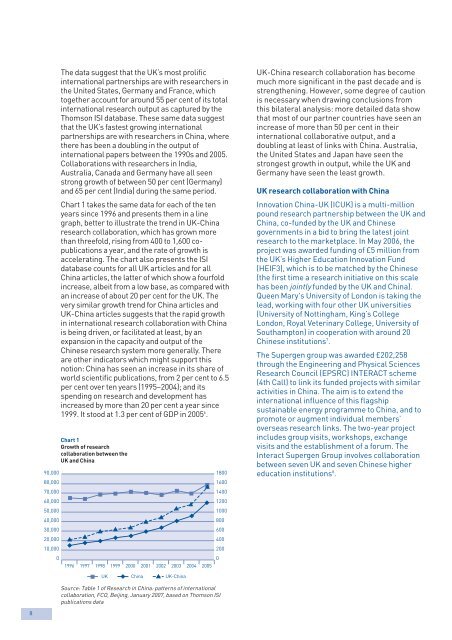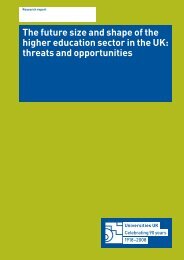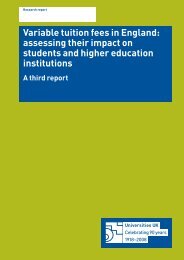International Research Collaboration - GlobalHigherEd
International Research Collaboration - GlobalHigherEd
International Research Collaboration - GlobalHigherEd
You also want an ePaper? Increase the reach of your titles
YUMPU automatically turns print PDFs into web optimized ePapers that Google loves.
90,00080,00070,00060,00050,00040,00030,00020,00010,0000The data suggest that the UK’s most prolificinternational partnerships are with researchers inthe United States, Germany and France, whichtogether account for around 55 per cent of its totalinternational research output as captured by theThomson ISI database. These same data suggestthat the UK’s fastest growing internationalpartnerships are with researchers in China, wherethere has been a doubling in the output ofinternational papers between the 1990s and 2005.<strong>Collaboration</strong>s with researchers in India,Australia, Canada and Germany have all seenstrong growth of between 50 per cent (Germany)and 65 per cent (India) during the same period.Chart 1 takes the same data for each of the tenyears since 1996 and presents them in a linegraph, better to illustrate the trend in UK-Chinaresearch collaboration, which has grown morethan threefold, rising from 400 to 1,600 copublicationsa year, and the rate of growth isaccelerating. The chart also presents the ISIdatabase counts for all UK articles and for allChina articles, the latter of which show a fourfoldincrease, albeit from a low base, as compared withan increase of about 20 per cent for the UK. Thevery similar growth trend for China articles andUK-China articles suggests that the rapid growthin international research collaboration with Chinais being driven, or facilitated at least, by anexpansion in the capacity and output of theChinese research system more generally. Thereare other indicators which might support thisnotion: China has seen an increase in its share ofworld scientific publications, from 2 per cent to 6.5per cent over ten years (1995–2004); and itsspending on research and development hasincreased by more than 20 per cent a year since1999. It stood at 1.3 per cent of GDP in 2005 6 .Chart 1Growth of researchcollaboration between theUK and China1996 1997 1998 19992000 2001 2002 2003 2004 2005180016001400120010008006004002000UK-China research collaboration has becomemuch more significant in the past decade and isstrengthening. However, some degree of cautionis necessary when drawing conclusions fromthis bilateral analysis: more detailed data showthat most of our partner countries have seen anincrease of more than 50 per cent in theirinternational collaborative output, and adoubling at least of links with China. Australia,the United States and Japan have seen thestrongest growth in output, while the UK andGermany have seen the least growth.UK research collaboration with ChinaInnovation China-UK (ICUK) is a multi-millionpound research partnership between the UK andChina, co-funded by the UK and Chinesegovernments in a bid to bring the latest jointresearch to the marketplace. In May 2006, theproject was awarded funding of £5 million fromthe UK’s Higher Education Innovation Fund(HEIF3), which is to be matched by the Chinese(the first time a research initiative on this scalehas been jointly funded by the UK and China).Queen Mary's University of London is taking thelead, working with four other UK universities(University of Nottingham, King’s CollegeLondon, Royal Veterinary College, University ofSouthampton) in cooperation with around 20Chinese institutions 7 .The Supergen group was awarded £202,258through the Engineering and Physical Sciences<strong>Research</strong> Council (EPSRC) INTERACT scheme(4th Call) to link its funded projects with similaractivities in China. The aim is to extend theinternational influence of this flagshipsustainable energy programme to China, and topromote or augment individual members’overseas research links. The two-year projectincludes group visits, workshops, exchangevisits and the establishment of a forum. TheInteract Supergen Group involves collaborationbetween seven UK and seven Chinese highereducation institutions 8 .UK China UK-ChinaSource: Table 1 of <strong>Research</strong> in China: patterns of internationalcollaboration, FCO, Beijing, January 2007, based on Thomson ISIpublications data8
















